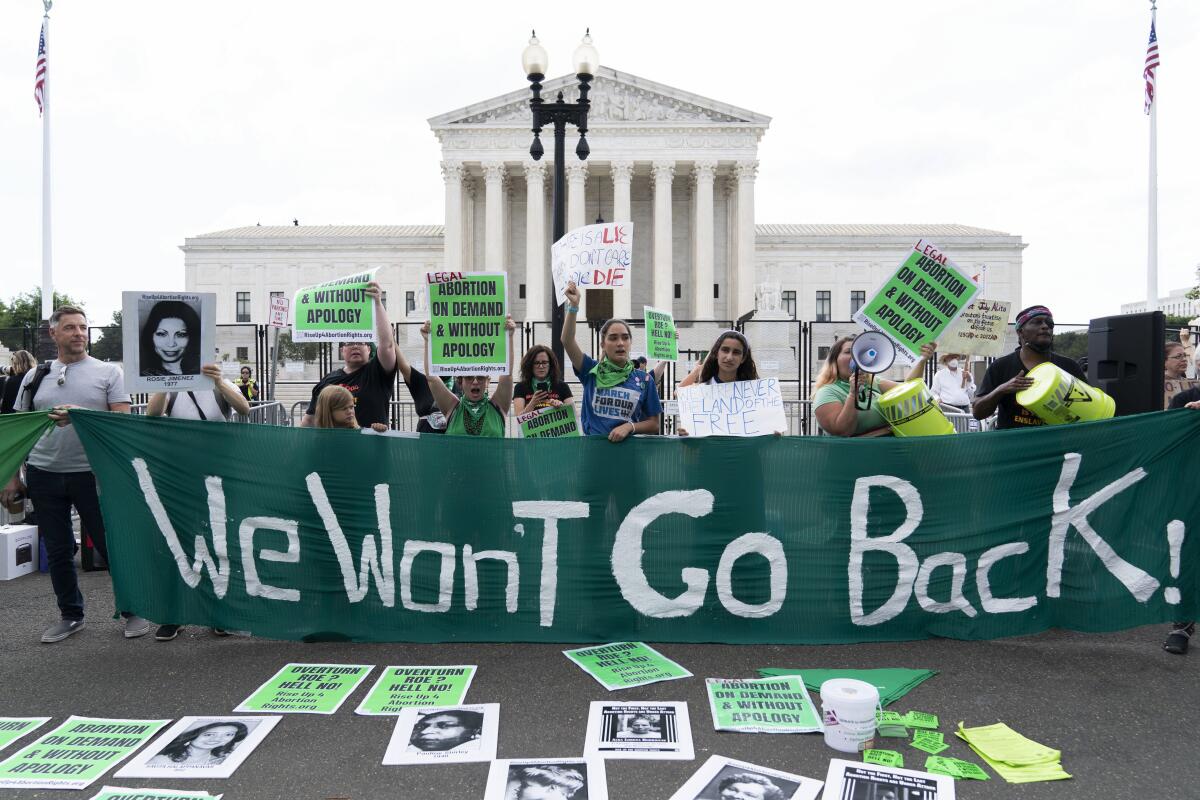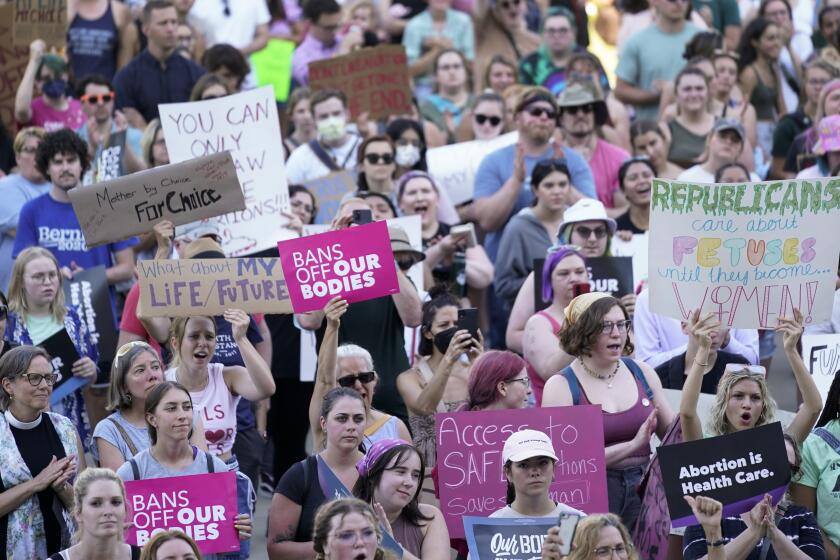Editorial: The fight over reproductive rights will play out in the states and courts in 2023

A little over six months ago, the Supreme Court overturned Roe vs. Wade, ending the constitutional right to an abortion and sending the nation back half a century to the time when state politicians decided whether women controlled their own bodies.
In the chaotic wake of that decision in the Dobbs vs. Jackson Women’s Health Organization case, trigger laws banning abortion went into effect in 13 states while others had pre-Roe bans that could be enacted. Some laws went into effect quickly; some did not. Some went into effect, then were blocked by court orders. Pregnant people didn’t know whether clinics were open. Clinic staff didn’t know whether they could open or not. People trekked to other states where abortion was legal, and clinics in those states scrambled to take on additional patients.
Meanwhile, abortion rights advocates filed dozens of lawsuits arguing that many state abortion bans were illegal because, though their legislatures may be hostile to abortion, the state constitutions’ protections for bodily autonomy and privacy rights extend to abortion. Sometimes they won, but often they just bought clinics more time to operate until a court hearing.
Currently, 12 states completely ban abortion while another state bans it at six weeks of gestation and two more ban it at 15 weeks, according to the Guttmacher Institute, a research group that supports abortion rights issues and tracks statistics. (Those numbers would be higher if advocates hadn’t taken state bans to court.) And 66 clinics across 15 states have been forced to stop providing abortions. A grim period of history had begun.
Voters in five states gave abortion rights a clear victory on election day.
But in the last six months, something exhilarating happened that bodes well for reproductive rights in 2023 and beyond. Voters defended the right to an abortion on the ballot from coast to coast in an exercise of power and self-determination. In the five states — blue, purple and red — where abortion was explicitly on the ballot in 2022, all the outcomes went in favor of abortion rights.
Three amendments enshrining a right to abortion in state constitutions in California, Vermont and Michigan passed resoundingly. Voters defeated measures in Kansas and Kentucky stating that abortion was not covered by the state constitution. Americans who went to the polls in November said abortion along with inflation were their top two concerns, according to an NBC News exit poll.
As we begin a new year without a federal constitutional right to abortion, the hurdles for access are still high. But if supporters and much of the electorate stay galvanized by the belief that they can restore a right that belonged to everyone for 49 years, then perhaps even more can be accomplished in 2023.
Abortion rights advocates are expected to press for more state initiatives explicitly protecting abortion access in state constitutions. Advocates are already focusing on getting citizen-led initiatives on the ballot in 10 states where abortion is banned or very restricted. Those are Arizona, Arkansas, Florida, Missouri, Montana, Nebraska, North Dakota, Ohio, Oklahoma and South Dakota.
Pushing for federal protection seems less effective — and unlikely to succeed. The House last year passed the Women’s Health Protection Act, which would have codified abortion rights into law. But not only did the Senate not pass that measure, it couldn’t even pass the Right to Contraception Act protecting the right to use birth control. It’s beyond comprehension that in the 21st century, lawmakers would find political reasons to be against a bill protecting contraception. With Republicans taking over control of the House, prospects for passing a national law protecting abortion appear bleak.
Another front on the abortion battle is access to medication to end pregnancy. Abortion rights advocates are trying to expand access, while opponents are trying to outlaw it. Alliance Defending Freedom, a conservative group, sued the Food and Drug Administration in November to get the agency to reverse its approval, granted decades ago, of mifepristone, one of the two drugs used for abortion medication. The group argues the agency did not study the medication enough and that it is unsafe.
It’s an absurd argument. Mifepristone has been used safely for decades, and is used, along with misoprostol, in more than half the abortions done in this country. But the lawsuit illustrates how far abortion opponents are willing to go to curb reproductive rights for everyone.
States should not be able to ban FDA-approved abortion pills from being mailed to anyone in the United States.
Since medication to end pregnancies can be sent through the mail and used at home, it should be beyond the grasp of state anti-abortion laws. The federal government should go to court to argue that FDA approval of drugs should not be second-guessed or overridden by states, whose powers are limited to regulating medical practices. That’s a fight, but it’s one worth having.
Abortion rights advocates will be spending much of their time in 2023 battling state abortion bans on the grounds that state constitutions protect basic rights and individual autonomy, even without an explicit provision on abortion rights. So far, 34 cases have been filed challenging abortion bans in 19 states.
More lawsuits will follow as state legislators pass new state bans. (A Virginia lawmaker proposed a complete ban on abortion for consideration during the state’s upcoming legislative session.) Up soon: Abortion rights advocates will argue before the Indiana Supreme Court this month that the state’s total abortion ban violates the state constitution. And the Wyoming Supreme Court will decide by next week whether to take up a challenge to the state’s trigger ban, which is blocked pending a court decision.
One state that has done especially well at protecting abortion rights is California. Legislators passed a dozen bills and set aside millions to help expand safe access to abortion and contraception for Californians and others who come here seeking abortion care. And in November, voters enshrined a right to abortion in the state Constitution through a measure put on the ballot by the Legislature.
Expanding abortion access is a difficult journey, but if the midterm election results are any indication, most Americans care deeply about protecting reproductive rights. We have seen that people can mobilize and vote for measures and elect state and federal lawmakers to support those rights. Our hope is that more people will stand up for their rights and more access to abortion will be restored in 2023.
More to Read
A cure for the common opinion
Get thought-provoking perspectives with our weekly newsletter.
You may occasionally receive promotional content from the Los Angeles Times.












